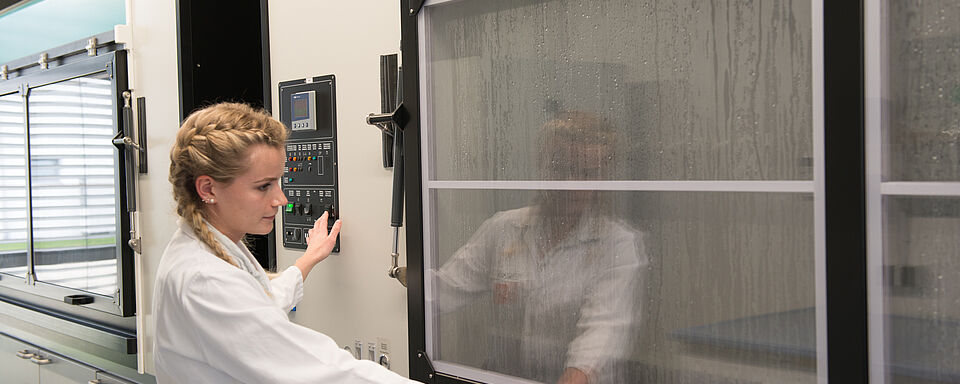Inspection of Corrosion Protection Systems: Salt Spray Test According to DIN EN ISO 9227 / ASTM B117
USE OF SALT SPRAY TESTING IN CORROSION PROTECTION ASSESSMENT
Corrosion is a widespread issue that affects materials and structures, potentially leading to significant damage, financial losses, and safety risks. Especially in industries such as automotive, transportation, aviation, construction, and maritime sectors, efficient corrosion protection is crucial to ensure the life span and reliability of materials and products.
To evaluate corrosion resistance and facilitate the selection of appropriate corrosion protection measures, the salt spray test, also known as the salt fog test, was developed in accordance with DIN EN ISO 9227. This standard defines the test conditions for the most widespread testing method of corrosion protection.
With our state-of-the-art salt spray chambers, we offer you a fast and reliable inspection of your components in compliance with DIN EN ISO 9227 and ASTM B117. Our chambers can accommodate large-sized samples of up to 2 meters in length. Additionally, we conduct corrosion cyclic tests according to common standards, including those from the automotive industry such as VDA 615-421, PV 1209, and PV 1210, which incorporate the salt spray test.
STANDARDIZED TESTING METHODS FOR CORROSION PROTECTION
The primary objective of DIN EN ISO 9227 is to establish standardized testing methods for corrosion protection. By defining fixed testing procedures, the standard allows for comparability of results. It specifies the conditions under which materials should be tested to determine their suitability for various environments.
However, it's important to note that the results obtained from the testing procedures in DIN EN ISO 9227 are not a direct measure of the actual resistance of materials in real-world conditions. Corrosion protection testing in controlled laboratory environments serves to assess comparative corrosion behavior and to test materials under accelerated conditions. Actual conditions can vary significantly, including the composition of the environment, temperature, humidity, and other factors that can influence corrosion.
DIN EN ISO 9227 does not specify the requirements that components must achieve. This applies to both the test duration and the evaluation methods carried out after testing.
TESTING PROCEDURES ACCORDING TO DIN EN ISO 9227
DIN EN ISO 9227 defines three different procedures for corrosion protection testing: the neutral salt spray test (NSS test), the copper-accelerated acetic acid salt spray test (CASS test), and the acetic acid salt spray test (AASS test)
Ensure a long lifespan and quality of your products. Assess and optimize your corrosion protection measures. We are your reliable partner for the necessary testing and evaluations. Get a free consultation now on +49 7171 / 10407-0.
POSSIBLE EVALUATIONS FOLLOWING DIN EN ISO 9227
After completing the salt spray test, the tested components are evaluated. Although DIN EN ISO 9227 does not provide specific guidelines in this regard, it refers to possible procedures that can be usefully applied. Some of the most common ones include:
1. Visual evaluation of the presence of corrosion products:
This involves checking if corrosion products are visible on the component. This is particularly useful for electroplated components.
2. Visual evaluation according to ISO 4628:
The ISO 4628 series of standards define the methods to be used for the visual assessment of coated surfaces after the salt spray test. These evaluation methods are often used for painted components and quantify parameters like blistering, rust formation, or adhesion loss at a scribe.
- Degree of blistering:
ISO 4628-2 enables the assessment of the degree of blistering on coated surfaces. It determines the extent of blistering, considering both the quantity and size of blisters. - Degree of rusting:
ISO 4628-3 provides an evaluation scheme for the degree of rusting on coated surfaces. It rates the level of rust formation on a scale from 0 to 5, with 0 indicating no rust and 5 indicating severe rust. - Adhesion loss at the scribe:
If a scribe is made in the coating before the test, adhesion can be assessed afterward in accordance with ISO 4628-8. It evaluates the distance from the scribe within which the coating can be detached.
Area of competence
Testing standards
- ASTM B 117
- DIN EN ISO 9227
Factory standards
This test is part of the following manufacturer and requirement standards:
Show standardsAAMA
AAMA 611Armasuisse
M040230-00 M040231-00BMW
GS 90010-1 GS 90011Daimler Buses
EVO 132.21Deutsche Bahn
DBS 918340Liebherr
LH 11007172Mercedes / Daimler
DBL 7382 DBL 7390 DBL 7391 DBL 8440 DBL 8451 DBL 9201 DBL 9440 DBL 9441 MBN 10494-6Porsche
PTL 7524Volkswagen
TL 182 TL 212 TL 217 TL 226 TL 244 TL 260 TL 52451Your contacts
M. Sc.
Teamleiter Korrosionsprüfung

Dipl.-Ing.
Projektingenieurin







